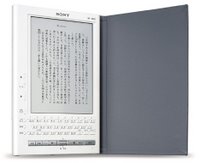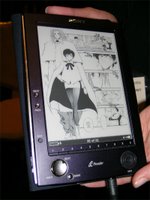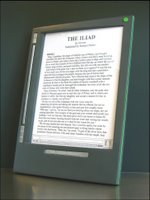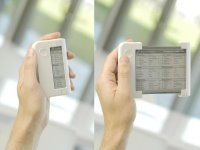E-Book/E-Mag/E-newspaper Reader
You guys know how I love ebooks and emags, even when I don't have a Palm/PDA which is more suitable for reading those electronic version of reading materials. I'm still using my desktop (when I was still in education in Jogja) or laptop (nowadays) for that. Can't afford PDA. Or could it be that is because I keep comparing the price of a Palm/PDA to the price of an imported fiction books? Besides, I imagine I will use a PDA only for reading ebooks, and ignoring other functions. I especially don't appreciate that PDA-phone. I believe in specializations, and when one small gadget can do many things, there is got to be some flaw in one of the functions.
A friend in Kafegaul Forum for Books, a forum of those bookreaders and things related to books (like gadgets and movies based on books), had brought the subject of e-readers for sometime. Looks like a multifunctional PDA is not enough. There is this E-Reader, too, specialized for reading electronic version of books, magazines, and newspapers. With the invention of E-Ink technology that makes the monochrome display LCD looks like a printed paper, makes you feel like reading a real book: no flicker, no backlight, looks clear in the sunlight, high resolution, and power economic). There are some e-reader products released in the market, although e-book, e-mags, and e-papers are still not as popular as their printed version. Some people still love that smell and the touch of paper.  Sony Librie was released by Philips, Sony, and E-ink in 2004. It's powered by Motorola DragonBall CPU, with Sony Linux OS. It has USB 2.0 port, headphone jack, and monaural speaker. There is a tiny qwerty keyboard and a small roller wheel at the bottom of the display. It shows ebooks in Broad Band eBook (BBeB) format. This version was sold only in Japan.
Sony Librie was released by Philips, Sony, and E-ink in 2004. It's powered by Motorola DragonBall CPU, with Sony Linux OS. It has USB 2.0 port, headphone jack, and monaural speaker. There is a tiny qwerty keyboard and a small roller wheel at the bottom of the display. It shows ebooks in Broad Band eBook (BBeB) format. This version was sold only in Japan.
- The black and white ink-on-paper look of the plastic display film is 170 pixels per inch (PPI) and resembles newsprint. Easily read in bright sunlight or dimly lit environments, the reflective screen designed by Philips only uses power when the image changes. A user can read more then 10,000 pages on four AAA Alkaline batteries. This technology also makes the e-book light and highly portable, measuring only 126 mm x 190 mm x 13 mm thick and weighing approximately 300 g (with battery). The 800x600 screen resolution is 6-inches of electronic ink plastic film, capable of displaying 4 shades of gray. The storage capacity is only 10MB and can hold around 500 downloaded books, if that is not enough you can add a maximum of 512MB with memory stick PRO.
 Sony Reader was released in the beginning of 2006, for US market. It's smaller, without any keyboard. The other features are mostly the same as its predecessor (and still monochromic), but it also supports SD flash memory cards. Battery life (Li-Ion) is said enough to do 7,500 page turns. And looks like this version can read BBeB, PDF, jpeg, and mp3. Still not good enough for me. I like my fictions read in .lit format. PDF formats are preferable when you read e-mags.
Sony Reader was released in the beginning of 2006, for US market. It's smaller, without any keyboard. The other features are mostly the same as its predecessor (and still monochromic), but it also supports SD flash memory cards. Battery life (Li-Ion) is said enough to do 7,500 page turns. And looks like this version can read BBeB, PDF, jpeg, and mp3. Still not good enough for me. I like my fictions read in .lit format. PDF formats are preferable when you read e-mags. Another e-reader is from iRex: Iliad Ebook Reader, 1024x768 pixels 8 inch display (16 level grayscale), with touch screen, support for external SD/MMC and CF II memory cards, USB 1.1, Wifi and Ethernet connections, and support for various audio/e-book formats (Pdf, xhtml, txt, mp3, other formats in the future). It is powered with 400MHz Intel XScale. It comes with 64MB RAM and 224MB Flash memory. Dimension: 155x216x16 mm, weight: 390 grams. Battery life is in excess of 20 hours. It's kinda big, but support more formats compared with SOny, and lots of memory. This things is released in 2006.
Another e-reader is from iRex: Iliad Ebook Reader, 1024x768 pixels 8 inch display (16 level grayscale), with touch screen, support for external SD/MMC and CF II memory cards, USB 1.1, Wifi and Ethernet connections, and support for various audio/e-book formats (Pdf, xhtml, txt, mp3, other formats in the future). It is powered with 400MHz Intel XScale. It comes with 64MB RAM and 224MB Flash memory. Dimension: 155x216x16 mm, weight: 390 grams. Battery life is in excess of 20 hours. It's kinda big, but support more formats compared with SOny, and lots of memory. This things is released in 2006. Jinke's Hanlin eBook Model V2 is produced by China, powered by 200 MHz Samsung ARM processor, 32MB SDRAM and 64MB NAND flash memory, 800x600 6-inch display, separate 254x96 "slave display" (there's touch screen function also in this slave), SD slot, and MP3 player. It is capable of reading PDF, HTML, converted DOC, TXT, PPT, and Excel documents (sounds like a PDA to me). The OS is Linux. Looks a lot like Librie, but Librie is much more elegant.
Jinke's Hanlin eBook Model V2 is produced by China, powered by 200 MHz Samsung ARM processor, 32MB SDRAM and 64MB NAND flash memory, 800x600 6-inch display, separate 254x96 "slave display" (there's touch screen function also in this slave), SD slot, and MP3 player. It is capable of reading PDF, HTML, converted DOC, TXT, PPT, and Excel documents (sounds like a PDA to me). The OS is Linux. Looks a lot like Librie, but Librie is much more elegant. And, last but not least: Philips Readius. It has roll-out display, based on Philips Polymer Vision’s PV-QML5 rollable display reference design. The screen has a 320 x 240 resolution, 4 gray levels and is 5-inches wide. The new 5-inch PV-QML5 rollable display has a decreased radius of curvature, improved operational and mechanical lifetime and paper-like viewing contrast. Significantly, this is a superior and improved version of the world’s first rollable display prototype introduced by none other than Philips’ owner of Polymer Vision back in February 2004.
And, last but not least: Philips Readius. It has roll-out display, based on Philips Polymer Vision’s PV-QML5 rollable display reference design. The screen has a 320 x 240 resolution, 4 gray levels and is 5-inches wide. The new 5-inch PV-QML5 rollable display has a decreased radius of curvature, improved operational and mechanical lifetime and paper-like viewing contrast. Significantly, this is a superior and improved version of the world’s first rollable display prototype introduced by none other than Philips’ owner of Polymer Vision back in February 2004.  When not actively used, the featherweight, ultra-thin portable device can be rolled up into a small housing with a radius in curvature of less than 7.5 mm. With four gray levels, the monochrome display provides paper-like viewing comfort with a high 10:1 contrast ratio for reading-intensive applications. Even in bright daylight, the display is easy to read. Using a bi-stable electro-phoretic display effect from E Ink Corp, the display consumes an exceptionally low amount of power.
When not actively used, the featherweight, ultra-thin portable device can be rolled up into a small housing with a radius in curvature of less than 7.5 mm. With four gray levels, the monochrome display provides paper-like viewing comfort with a high 10:1 contrast ratio for reading-intensive applications. Even in bright daylight, the display is easy to read. Using a bi-stable electro-phoretic display effect from E Ink Corp, the display consumes an exceptionally low amount of power.




0 Comments: